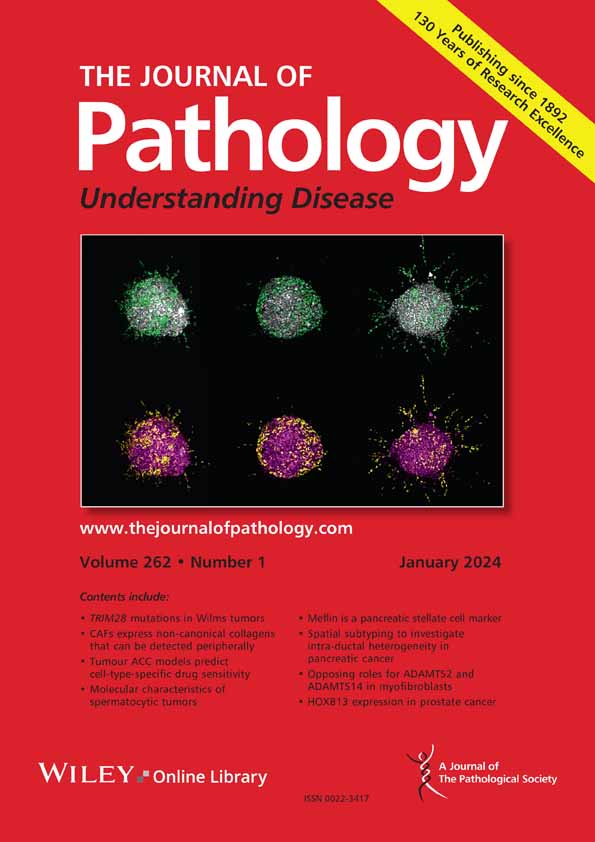Aaron O. Angerstein, Lyndsay E.A. Young, Thatchawan Thanasupawat, Jerry Vriend, Grace Grimsley, Xueqing Lun, Donna L. Senger, Namita Sinha, Jason Beiko, Marshall Pitz, Sabine Hombach-Klonisch, Richard R. Drake, Thomas Klonisch
求助PDF
{"title":"Distinct spatial N-glycan profiles reveal glioblastoma-specific signatures","authors":"Aaron O. Angerstein, Lyndsay E.A. Young, Thatchawan Thanasupawat, Jerry Vriend, Grace Grimsley, Xueqing Lun, Donna L. Senger, Namita Sinha, Jason Beiko, Marshall Pitz, Sabine Hombach-Klonisch, Richard R. Drake, Thomas Klonisch","doi":"10.1002/path.6401","DOIUrl":null,"url":null,"abstract":"<p>This study explored the complex interactions between glycosylation patterns, tumour biology, and therapeutic responses to temozolomide (TMZ) in human malignant glioma, specifically CNS WHO grade 3 oligodendroglioma (ODG) and glioblastoma (GB). Using spatial imaging of N-glycans in formalin-fixed paraffin-embedded (FFPE) tissue sections via MALDI-MSI, we analysed the N-glycome in primary and recurrent GB tissues and orthotopic xenografts of patient-derived brain tumour-initiating cells (BTIC) sensitive or resistant to TMZ. We identified unique N-glycosylation profiles, with nontumor brain (NTB) and ODG showing higher levels of bisecting and tri-antennary structures, while GB exhibited more tetra-antennary and sialylated N-glycans. Distinctive sialylation patterns were observed, with specific α2,6 and α2,3 isomeric linkages significantly altered in GB. Moreover, comparative analysis of primary and recurrent GB tissues revealed elevated high mannose N-glycans in primary GB and fucosylated bi- and tri-antennary N-glycans in recurrent GB tissues. Next, in the orthotopic xenografts of TMZ-sensitive and TMZ-resistant patient brain tumour initiating cells (BTIC), we identified potential N-glycan markers for TMZ treatment response and resistance. Finally, we found significantly altered expression of genes involved in N-glycan biosynthesis in malignant glioma, highlighting the crucial role of N-glycans in glioma and therapy resistance. This study lays the foundation for developing glycosylation-based diagnostic biomarkers and targeted therapies, potentially improving clinical outcomes for GB patients. © 2025 The Pathological Society of Great Britain and Ireland.</p>","PeriodicalId":232,"journal":{"name":"The Journal of Pathology","volume":"265 4","pages":"486-501"},"PeriodicalIF":5.2000,"publicationDate":"2025-02-19","publicationTypes":"Journal Article","fieldsOfStudy":null,"isOpenAccess":false,"openAccessPdf":"","citationCount":"0","resultStr":null,"platform":"Semanticscholar","paperid":null,"PeriodicalName":"The Journal of Pathology","FirstCategoryId":"3","ListUrlMain":"https://pathsocjournals.onlinelibrary.wiley.com/doi/10.1002/path.6401","RegionNum":2,"RegionCategory":"医学","ArticlePicture":[],"TitleCN":null,"AbstractTextCN":null,"PMCID":null,"EPubDate":"","PubModel":"","JCR":"Q1","JCRName":"ONCOLOGY","Score":null,"Total":0}
引用次数: 0
引用
批量引用
Abstract
This study explored the complex interactions between glycosylation patterns, tumour biology, and therapeutic responses to temozolomide (TMZ) in human malignant glioma, specifically CNS WHO grade 3 oligodendroglioma (ODG) and glioblastoma (GB). Using spatial imaging of N-glycans in formalin-fixed paraffin-embedded (FFPE) tissue sections via MALDI-MSI, we analysed the N-glycome in primary and recurrent GB tissues and orthotopic xenografts of patient-derived brain tumour-initiating cells (BTIC) sensitive or resistant to TMZ. We identified unique N-glycosylation profiles, with nontumor brain (NTB) and ODG showing higher levels of bisecting and tri-antennary structures, while GB exhibited more tetra-antennary and sialylated N-glycans. Distinctive sialylation patterns were observed, with specific α2,6 and α2,3 isomeric linkages significantly altered in GB. Moreover, comparative analysis of primary and recurrent GB tissues revealed elevated high mannose N-glycans in primary GB and fucosylated bi- and tri-antennary N-glycans in recurrent GB tissues. Next, in the orthotopic xenografts of TMZ-sensitive and TMZ-resistant patient brain tumour initiating cells (BTIC), we identified potential N-glycan markers for TMZ treatment response and resistance. Finally, we found significantly altered expression of genes involved in N-glycan biosynthesis in malignant glioma, highlighting the crucial role of N-glycans in glioma and therapy resistance. This study lays the foundation for developing glycosylation-based diagnostic biomarkers and targeted therapies, potentially improving clinical outcomes for GB patients. © 2025 The Pathological Society of Great Britain and Ireland.
不同的空间n -聚糖谱揭示了胶质母细胞瘤的特异性特征。
本研究探讨了糖基化模式、肿瘤生物学和替莫唑胺(TMZ)治疗人类恶性胶质瘤(特别是中枢神经系统WHO 3级少突胶质细胞瘤(ODG)和胶质母细胞瘤(GB)之间的复杂相互作用。利用MALDI-MSI对福尔马林固定石蜡包埋(FFPE)组织切片的n-糖聚糖进行空间成像,我们分析了原发性和复发性GB组织以及对TMZ敏感或耐药的患者源性脑肿瘤起始细胞(BTIC)原位异种移植物中的n-糖聚糖。我们鉴定出了独特的n -糖基化谱,非肿瘤脑(NTB)和ODG显示出更高水平的等分和三天线结构,而GB显示出更多的四天线和唾液化的n -聚糖。不同的唾液化模式观察到,特定的α2,6和α2,3异构体键在GB中显著改变。此外,对原发性和复发性GB组织的比较分析显示,原发性GB组织中高甘露糖n -聚糖升高,复发性GB组织中双天线和三天线n -聚糖集中。接下来,在TMZ敏感和TMZ耐药患者脑肿瘤起始细胞(BTIC)的原位异种移植物中,我们确定了TMZ治疗反应和耐药的潜在n -聚糖标记物。最后,我们发现恶性胶质瘤中参与n -聚糖生物合成的基因表达显著改变,突出了n -聚糖在胶质瘤和治疗耐药中的重要作用。该研究为开发基于糖基化的诊断生物标志物和靶向治疗奠定了基础,有可能改善GB患者的临床结果。©2025英国和爱尔兰病理学会。
本文章由计算机程序翻译,如有差异,请以英文原文为准。






 求助内容:
求助内容: 应助结果提醒方式:
应助结果提醒方式:


